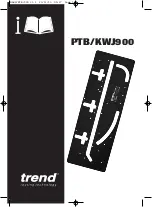
PTB/KWJ900
-8-
ASSEMBLY
Location Bush Identification
Three location bushes are used in different holes
in the jig to align the correct template aperture
for the application.
The holes are coded for easy identification with
dots as follows:
F
–
Female Joint
M
–
Male Joint
H
–
Hob Mitre Joint
B
–
Connector Bolt Recess
A
–
45° Angle End
P
–
Curved Peninsular
R
–
Radius Corner
Setting out the Joints
When cutting a joint ensure location bushes
contact the postformed edge of the worktop. For
certain joints the worktop will need to be inverted
so that all cuts are made into the postformed
edge, never out through it. When routing worktop
the balancing paper on the underside may feather
edge – this feather edge should be removed with
abrasive paper.
Location bushes are held in position by ‘O’ rings.
Insert the smallest end of the bush into the hole
by lightly pushing and turning at the same time.
If the bushes are tight use a lubricant on the ‘O’
ring. Ensure bushes are fully home before use.
When using jig ensure location bushes do not
foul workbench.
In order to prevent breakout of the
laminate, rotation of the cutter and
feed direction must always be into the
postform edge of the worktop.
Margin Distance
Allow 8.5mm when cutting joints. Measure or
use a batten of this
thickness to aid
setting out.
Cutter
Sub base
Guide bush
30mmØ
Location
bush
Worktop
Template
8.5mm
28mm
Plan view
of joints
Right hand joint
Male
Female
Male
Female
Cut
male
with laminate down
Cut
female
with laminate up
Postform edge
The joint takes up 28mm, this should
be allowed for with extra material in the
length of the male worktop.
Male
Female
Postform edge
PENINSULAR
Postform edge
Postform edge
Male
Female
Left hand joint
Cut
male
with laminate up
Cut
female
with laminate down
O ring
Location
bush
MANU/PTB/900 v1.1 23/11/10 09:27 Page 8





































